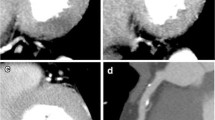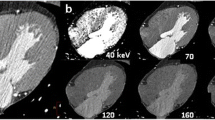Abstract
Purpose of Review
To provide an updated review on the applications of dual-energy CT (DECT) for cardiac and coronary imaging and the clinical impact therein. This review also attempts to provide guidance for the appropriate clinical use of DECT of the heart.
Recent Findings
Simultaneous image acquisition at different kilovolt (kV) levels using DECT techniques offers a wide range of post-processing capabilities for cardiac imaging. Initially used for research purposes, this emerging technique is slowly being adopted into clinical routine for both coronary and myocardial imaging. Former limitations have been addressed in the development of DECT hardware and software. In addition to heavily validated analytical DECT approaches, various investigational techniques are evolving that may provide clinical value in the future.
Conclusion
DECT leads to more comprehensive and accurate diagnosis of myocardial and coronary disease by providing several ancillary analyses in addition to conventional CT images. However, the application of DECT should continue to be refined and further validated in future studies.


Similar content being viewed by others
References
Papers of particular interest, published recently, have been highlighted as: ∙∙ Of major importance
Coursey CA, Nelson RC, Boll DT, et al. Dual-energy multidetector CT: how does it work, what can it tell us, and when can we use it in abdominopelvic imaging? Radiographics. 2010;30(4):1037–55.
∙∙ Johnson TRC. Dual-energy CT: general principles. Am J Roentgenol. 2012;199(5_supplement):S3–8. It represents excellent review article that is complimentary to this article.
∙∙ Albrecht MH, Bickford MW, Nance JW, et al. State-of-the-art pulmonary CT angiography for acute pulmonary embolism. Am J Roentgenol. 2017;208(3):495–504. It represents excellent review article that is complimentary to this article.
∙∙ Vliegenthart R, Pelgrim GJ, Ebersberger U, et al. Dual-energy CT of the heart. Am J Roentgenol. 2012;199(5_supplement):S54–63. It represents excellent review article that is complimentary to this article.
∙∙ Albrecht MH, Scholtz J-E, Hüsers K, et al. Advanced image-based virtual monoenergetic dual-energy CT angiography of the abdomen: optimization of kiloelectron volt settings to improve image contrast. Eur Radiol. 2015;26(6):1863–70. It is a very important primary research paper, introducing novel evidence regarding DECT. This study is also very well conducted.
Meinel FG, Canstein C, Schoepf UJ, et al. Image quality and radiation dose of low tube voltage 3rd generation dual-source coronary CT angiography in obese patients: a phantom study. Eur Radiol. 2014;24(7):1643–50.
Tesche C, De Cecco CN, Vliegenthart R, et al. Accuracy and radiation dose reduction using low-voltage computed tomography coronary artery calcium scoring with tin filtration. Am J Cardiol. 2017;119(4):675–80.
Koonce JD, Vliegenthart R, Schoepf UJ, et al. Accuracy of dual-energy computed tomography for the measurement of iodine concentration using cardiac CT protocols: validation in a phantom model. Eur Radiol. 2014;24(2):512–8.
Weininger M, Schoepf UJ, Ramachandra A, et al. Adenosine-stress dynamic real-time myocardial perfusion CT and adenosine-stress first-pass dual-energy myocardial perfusion CT for the assessment of acute chest pain: initial results. Eur J Radiol. 2012;81(12):3703–10.
∙∙ De Cecco CN, Harris BS, Schoepf UJ, et al. Incremental value of pharmacological stress cardiac dual-energy CT over coronary CT angiography alone for the assessment of coronary artery disease in a high-risk population. Am J Roentgenol. 2014;203(1):W70–7. It is a very important primary research paper, introducing novel evidence regarding DECT. This study is also very well conducted.
So A, Hsieh J, Imai Y, et al. Prospectively ECG-triggered rapid kV-switching dual-energy CT for quantitative imaging of myocardial perfusion. JACC Cardiovasc Imaging. 2012;5(8):829–36.
Jin KN, De Cecco CN, Caruso D, et al. Myocardial perfusion imaging with dual energy CT. Eur J Radiol. 2016. http://linkinghub.elsevier.com/retrieve/pii/S0720048X16302091. Accessed September 14, 2016.
∙∙ Varga-Szemes A, Meinel FG, De Cecco CN, et al. CT myocardial perfusion imaging. Am J Roentgenol. 2015;204(3):487–97. It represents excellent review article that is complimentary to this article.
Siegel MJ, Kaza RK, Bolus DN, et al. White paper of the society of computed body tomography and magnetic resonance on dual-energy CT, part 1: technology and terminology. J Comput Assist Tomogr. 2016;40(6):841–5.
Ruzsics B, Lee H, Zwerner PL, et al. Dual-energy CT of the heart for diagnosing coronary artery stenosis and myocardial ischemia-initial experience. Eur Radiol. 2008;18(11):2414–24.
Wang R, Yu W, Wang Y, et al. Incremental value of dual-energy CT to coronary CT angiography for the detection of significant coronary stenosis: comparison with quantitative coronary angiography and single photon emission computed tomography. Int J Cardiovasc Imaging. 2011;27(5):647–56.
∙∙ De Cecco CN, Schoepf UJ, Steinbach L, et al. White paper of the society of computed body tomography and magnetic resonance on dual-energy CT, part 3: vascular, cardiac, pulmonary, and musculoskeletal applications. J Comput Assist Tomogr. 2017;41(1):1–7. It is a very important primary research paper, introducing novel evidence regarding DECT. This study is also very well conducted.
Kerl JM, Deseive S, Tandi C, et al. Dual energy CT for the assessment of reperfused chronic infarction—a feasibility study in a porcine model. Acta Radiol. 2011;52(8):834–9.
Zhang L-J, Peng J, Wu S-Y, et al. Dual source dual-energy computed tomography of acute myocardial infarction: correlation with histopathologic findings in a canine model. Invest Radiol. 2010;45(6):290–7.
Peng J, Zhang LJ, Schoepf UJ, et al. Acute myocardial infarct detection with dual energy CT: correlation with single photon emission computed tomography myocardial scintigraphy in a canine model. Acta Radiol. 2013;54(3):259–66.
Bauer RW, Kerl JM, Fischer N, et al. Dual-energy CT for the assessment of chronic myocardial infarction in patients with chronic coronary artery disease: comparison with 3-T MRI. AJR Am J Roentgenol. 2010;195(3):639–46.
Deseive S, Bauer RW, Lehmann R, et al. Dual-energy computed tomography for the detection of late enhancement in reperfused chronic infarction: a comparison to magnetic resonance imaging and histopathology in a porcine model. Invest Radiol. 2011;46(7):450–6.
Meinel FG, De Cecco CN, Schoepf UJ, et al. First-arterial-pass dual-energy CT for assessment of myocardial blood supply: do we need rest, stress, and delayed acquisition? Comparison with SPECT. Radiology. 2014;270(3):708–16.
∙∙ Albrecht MH, Trommer J, Wichmann JL, et al. Comprehensive comparison of virtual monoenergetic and linearly blended reconstruction techniques in third-generation dual-source dual-energy computed tomography angiography of the thorax and abdomen. Invest Radiol. 2016;51(9):582–90. It is a very important primary research paper, introducing novel evidence regarding DECT. This study is also very well conducted.
Albrecht MH, Scholtz J-E, Kraft J, et al. Assessment of an advanced monoenergetic reconstruction technique in dual-energy computed tomography of head and neck cancer. Eur Radiol. 2015;25(8):2493–501.
∙∙ Grant KL, Flohr TG, Krauss B, et al. Assessment of an advanced image-based technique to calculate virtual monoenergetic computed tomographic images from a dual-energy examination to improve contrast-to-noise ratio in examinations using iodinated contrast media. Invest Radiol. 2014;49(9):586–92. It is a very important primary research paper, introducing novel evidence regarding DECT. This study is also very well conducted.
Wichmann JL, Nöske E-M, Kraft J, et al. Virtual monoenergetic dual-energy computed tomography: optimization of kiloelectron volt settings in head and neck cancer. Invest Radiol. 2014;49(11):735–41.
Apfaltrer P, Sudarski S, Schneider D, et al. Value of monoenergetic low-kV dual energy CT datasets for improved image quality of CT pulmonary angiography. Eur J Radiol. 2014;83(2):322–8.
Sudarski S, Apfaltrer P, Nance JW, et al. Optimization of keV-settings in abdominal and lower extremity dual-source dual-energy CT angiography determined with virtual monoenergetic imaging. Eur J Radiol. 2013;82(10):e574–81.
Martin SS, Albrecht MH, Wichmann JL, et al. Value of a noise-optimized virtual monoenergetic reconstruction technique in dual-energy CT for planning of transcatheter aortic valve replacement. Eur Radiol. 2017;27(2):705–14.
Beeres M, Trommer J, Frellesen C, et al. Evaluation of different keV-settings in dual-energy CT angiography of the aorta using advanced image-based virtual monoenergetic imaging. Imaging: Int J Cardiovasc.; 2015.
Foley WD, Shuman WP, Siegel MJ, et al. White paper of the society of computed body tomography and magnetic resonance on dual-energy CT, part 2: radiation dose and iodine sensitivity. J Comput Assist Tomogr. 2016;40(6):846–50.
Bamberg F, Dierks A, Nikolaou K, et al. Metal artifact reduction by dual energy computed tomography using monoenergetic extrapolation. Eur Radiol. 2011;21(7):1424–9.
So A, Hsieh J, Narayanan S, et al. Dual-energy CT and its potential use for quantitative myocardial CT perfusion. J Cardiovasc Comput Tomogr. 2012;6(5):308–17.
Fuchs TA, Sah B-R, Stehli J, et al. Attenuation correction maps for SPECT myocardial perfusion imaging from contrast-enhanced coronary CT angiography: gemstone spectral imaging with single-source dual energy and material decomposition. J Nucl Med. 2013;54(12):2077–80.
Matsui K, Machida H, Mitsuhashi T, et al. Analysis of coronary arterial calcification components with coronary CT angiography using single-source dual-energy CT with fast tube voltage switching. Int J Cardiovasc Imaging. 2015;31(3):639–47.
Mahoney R, Pavitt CW, Gordon D, et al. Clinical validation of dual-source dual-energy computed tomography (DECT) for coronary and valve imaging in patients undergoing trans-catheter aortic valve implantation (TAVI). Clin Radiol. 2014;69(8):786–94.
Kumar V, Min JK, He X, et al. Computation of calcium score with dual-energy computed tomography: a phantom study. J Comput Assist Tomogr. 2017;41(1):156–8.
Yamak D, Pavlicek W, Boltz T, et al. Coronary calcium quantification using contrast-enhanced dual-energy computed tomography scans. J Appl Clin Med Phys. 2013;14(3):4014.
Matsuda T, Kido T, Itoh T, et al. Diagnostic accuracy of late iodine enhancement on cardiac computed tomography with a denoise filter for the evaluation of myocardial infarction. Int J Cardiovasc Imaging. 2015;31(S2):177–85.
Funabashi N, Irie R, Namihira Y, et al. Influence of tube voltage and heart rate on the Agatston calcium score using an in vitro, novel ECG-gated dual energy reconstruction 320 slice CT technique. Int J Cardiol. 2015;180:218–20.
Henzler T, Porubsky S, Kayed H, et al. Attenuation-based characterization of coronary atherosclerotic plaque: comparison of dual source and dual energy CT with single-source CT and histopathology. Eur J Radiol. 2011;80(1):54–9.
Ravanfar Haghighi R, Chatterjee S, Tabin M, et al. DECT evaluation of noncalcified coronary artery plaque: DECT based evaluation of noncalcified plaque. Med Phys. 2015;42(10):5945–54.
Obaid DR, Calvert PA, Gopalan D, et al. Dual-energy computed tomography imaging to determine atherosclerotic plaque composition: A prospective study with tissue validation. J Cardiovasc Comput Tomogr. 2014;8(3):230–7.
Bandula S, White SK, Flett AS, et al. Measurement of myocardial extracellular volume fraction by using equilibrium contrast-enhanced CT: validation against histologic findings. Radiology. 2013;269(2):396–403.
Lee H-J, Im DJ, Youn J-C, et al. Myocardial extracellular volume fraction with dual-energy equilibrium contrast-enhanced cardiac CT in nonischemic cardiomyopathy: a prospective comparison with cardiac MR imaging. Radiology. 2016;280(1):49–57.
Hazirolan T, Akpinar B, Unal S, et al. Value of dual energy computed tomography for detection of myocardial iron deposition in Thalassaemia patients: initial experience. Eur J Radiol. 2008;68(3):442–5.
Author information
Authors and Affiliations
Corresponding author
Ethics declarations
Conflict of Interest
Moritz H. Albrecht, John W. Nance Jr, Domenico De Santis, Marwen Eid, Christian Tesche, Georg Apfaltrer, Brian Jacobs, Thomas J. Vogl each declare no potential conflicts of interest. U. Joseph Schoepf is a consultant for and/or receives research support from Astellas, Bayer, Bracco, GE, and Siemens. Dr. Schoepf is a section editor for Current Radiology Reports. Carlo N. De Cecco is a consultant for and/or receives research support from Guerbet and Siemens. Akos Varga-Szemes is a consultant for Guerbet.
Human and Animal Rights and Informed Consent
This article does not contain any studies with human or animal subjects performed by any of the authors.
Additional information
This article is part of the Topical collection on Dual Energy CT.
Rights and permissions
About this article
Cite this article
Albrecht, M.H., De Cecco, C.N., Nance, J.W. et al. Cardiac Dual-Energy CT Applications and Clinical Impact. Curr Radiol Rep 5, 42 (2017). https://doi.org/10.1007/s40134-017-0237-5
Published:
DOI: https://doi.org/10.1007/s40134-017-0237-5




